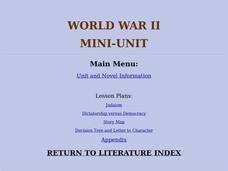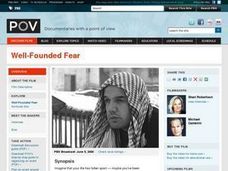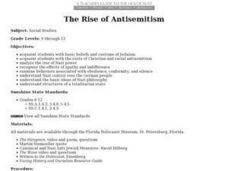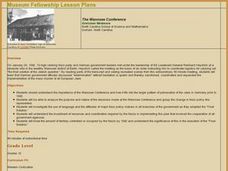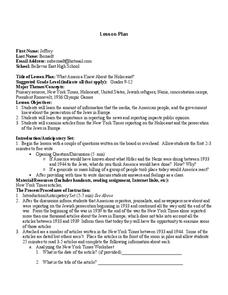University of Southern California
Persecution of the German-Jews: The Early Years - 1933-1939
Young historians learn about the dehumanization process of stripping German Jews of basic, fundamental rights prior to the genocide of European Jews in the 1940s. Learners watch video clips of survivors who recount such events...
Museum of Tolerance
Making Lemonade: Responding to Oppression in Empowering Ways
An activity focused on tolerance encourages class members to consider how they might respond when they or someone else is the target of oppression and discrimination. After researching how some key figures responded to the...
Curated OER
Writing Exercises: Jews during the Middle Ages
After exploring the life of Jewish people in Europe during the Middle Ages, have the class complete three writing prompts. They'll compose three responses that discuss anti-Semitism, Jewish contribution, and persecution of Jewish people.
Curated OER
Immigration to the Golden Land: Jewish Life in America
Students examine waves of Jewish immigration during three time periods and analyze a variety of primary sources, including letters, memoirs, and laws, to gain insight into both the American immigrant experience and American society...
Curated OER
Judaism
Students brainstorm what they know about Judaism, participate in question and answer session about Judaism and its relation to World War II with guest speaker of Jewish faith, and write journal responses about their feelings on...
Curated OER
Propaganda, WWII, Ghetto‘s, and Analysis of Primary Resources
Students consider the implications of anti-Semitism. In this World War II lesson, students examine selected documents and images featuring the propaganda that promoted Jewish persecution. Students write essays that highlight how the Nazi...
Curated OER
"You're Probably Tired, Dear Diary" - Children's Diaries during the Holocaust
As part of the study of WWII and the Holocaust, class members read a series of diary entries written by children during the onslaught of Nazi occupation. Each entry is accompanied by biographical information and discussion questions. The...
Curated OER
Who Was Anne Frank
Introduce eyewitness accounts of World War II with this presentation. It provides a very brief summary of the life of Anne Frank, along with several descriptive excerpts from her diary. While the resource appears to have been made by a...
Curated OER
Jewish Women: Chief Cooks of Culture, Family, And Community
Students explore and analyze how one's culture, food, family and community end up having or shaping our environments as well as determine our destiny's. Food preparation serves as a key component in a Jewish woman's makeup and strength...
Curated OER
The Lily Cupboard by Shulamith Ley Oppenheim
Students demonstrate knowledge of what a hero does, discuss concepts of persecution and hiding, identify ways Nazis persecuted Jews, and analyze reasons and motivations that caused people to take a stand.
Curated OER
A Teacher's Guide to the Holocaust: Shemini Atzeret-Simhat Torah
High schoolers explore Jewish traditions through Jewish art. In this interdisciplinary lesson, students research art by Moshe Rynecki, Chaim Goldberg and Emmanuel Levy. High schoolers replicate the artistic styles in their own pieces.
Curated OER
Asylum Talk Show
Young scholars investigate the case of a German ship containing Jewish refugees seeking asylum from Nazi persecution in the late 1930s. They conduct Internet research, watch a video, and role-play passengers from the St. Louis on a...
Curated OER
Rescuers: Those Who Risked Their Lives to Save Others
Learners examine stories of Holocaust heroes. In this Holocaust lesson, students study the contributions of those who saved Jewish prisoners. Learners compose reflective essays pertaining to the topic.
Curated OER
Requiem The Song of the Murdered Jewish People
Students read poem The Song of the Murdered Jewish People, listen to Requiem based on poem, work on reading poem as music plays, discuss reasons for composer's musical choices, and investigate possibilities of performing a reading for an...
Curated OER
Freedom from Oppression
Students investigate instances of genocide and role play as reporters writing news stories and editorials.
Curated OER
The Rise of Christianity
Examine one of the 7 major world religions, how it began and spread throughout the globe. Upper graders can view this presentation to better understand the social and political impacts that Christianity had on Rome and western civilization.
Curated OER
Forgotten Daughters
Students research gender oppression in Nazi Germany and organize and develop presentations. They identify patriarchal and Fascist policies in Nazi Germany.
Curated OER
The Wannsee Conference
Twelfth graders examine what occured at the Wannsee Conference during World War II. Using documents, they discover how the conference fits into the final solution of the Jewish question. They analyze the language used and the attitudes...
Curated OER
What America Knew About the Holocaust?
Learners examine American involvement in World War II. In this World War II lesson, students discuss the Holocaust and its implications. Learners read New York Times articles regarding the treatment of Jews during the war. Students infer...
Curated OER
The Power of Words Anti-Semitism and Hate Speech
Learners investigate words associated with Anti-Semitism and hate. They view and discuss a video about teaching tolerance focusing on language usage.
Curated OER
Anne Frank: Everything Changed for Us
Students write about a time they were made to feel different, and when they were on the other side of the equation. They read other first hand accounts of times in history when people were made to feel like outsiders.
Curated OER
Art in Nazi Germany When Art and Politics Didn't Agree
Five lessons display the art created by Germans under the Weimar Republic. The focus of these lessons is to help learners understand the role of art in politics, government censorship, and Nazi tactics. Web links are included.
Roy Rosenzweig Center for History and New Media
Immigration: Why Come to the United States?
Don't limit your curriculum to texts! Young historians listen to a song, read an interview, and examine a cartoon as they explore motivations for immigrating to the US in the late 19th and early 20th centuries.




